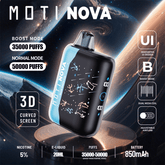Coils: A Lesson in the Science Behind Coil Construction and a Few Words About Electromagnetism
-
If you're one of the many people who are thinking about making the plunge into DIY vaping, then, like everyone else, you'll have a few things to learn. These days, most self-education in coil-building consists of watching instructional videos or reading an online guide. If you're lucky, you'll get a friend to show you. Once you're finished though, no matter how you've learned, (and after you've had some practice), you'll be delighted to find that you are now master of your own domain. No longer are you required to buy ready-made coils when your favorite juice has gunked up and blackened your cotton. And what's more? You'll find that coil-building is fun. There is a satisfaction that comes with creating something with a mechanical purpose. It's like working on your car or fixing the sink. You feel a little bit like an engineer; like a practical artist.

(DISCLAIMER) This blog post will not be a lesson in how to build your own coils, but will instead focus on the science and skill behind coil-building and the differences between various coil structures. A lot of the information users are provided with while learning how to build coils excludes the fascinating science behind coil performance and electromagnetism. What follows will be a detailed explanation of how your coil's resistance affects your atomizer and will include some interesting details about different coil structures. After that, we'll talk about ready-made performance coils, which allow RDA and RTA users to forego the task of building coils, and discuss why such coils have become popular.
Let's get started.
Ohm's Law
The material, diameter, and surface area of your coils affect their ohm rating. Ohms are the units that we use to express resistance. Resistance affects your atomizer's electrical current and power output, resulting in differences in the way your vapor tastes and how much quantity of vapor your machine will produce. Ohm's Law provides us with an equation for finding the current (I) of your system.

Current (I) is described as the amount of electrical charge flowing through a material (like a wire) per second. This is what we traditionally think of as electricity: a flow of electrons running down a wire, providing a current that makes certain things (like your computer or cell phone) function.
Voltage (V) actually means voltage difference. It is a unit for the difference in electrical potential energy between two points (such as a positive and a negative terminal in a battery). A higher voltage difference means that a certain amount of charge will produce more energy, compared to if it was moved across a lower voltage.
Current is measured in amps (A). Resistance is measured in ohms (Ω).
Power is measured in watts (W). It is a measure of energy over time and is most important for a machine that seeks to produce heat. The equations for finding power in relation to current, voltage, and resistance are:
P = V^2 / R P = I^2R P = VI
This is how you find the wattage output of your device.
What Does This Mean?
The atomizer of your build works by heating a coil, which in turn burns the vegetable-glycerin-based E-Liquid soaked into the cotton that coil is touching, resulting in the production of a gaseous "vapor" that you can inhale through a targeted airflow system. But how does the atomizer actually heat the coil? Well... with resistance.
Electrical resistance means that when electrical energy is running through a material, it is actually bumping up against stuff, losing momentum, and creating friction. This friction creates heat, like you feel when you rub your hands together. The "waste energy" from this friction is actually what makes your vape work. So you see, how much heat you produce is directly related to what kind of coil you are using and how much resistance that coil has.

Different Kinds of Wire
There are five different kinds of wire that are used to create coils: Kanthal (Ka), NiChrome (Ni80), Nickel Wire (Ni200), Titanium (Ti), and Stainless Steel (SS).
Kanthal is the original vape wire; user-friendly and inexpensive, learning to build with Kanthal is an easy task. Its elasticity and shape memory make it ideal for creating surface area while making an inner diameter large enough to fit your cotton.
***The greater the surface area, the more flavor you get out of your vape***
NiChrome heats up more rapidly than Kanthal and also gives you more flavor from your E-Liquid.
Nickel Wire almost has zero resistance to electric current, creating a ramp up time that is extremely quick. Unfortunately, it has a bad habit of melting at a higher wattage. Temperature Control, then, is used primarily when using Nickel Wire coils. In TC mode on many devices, you will find a dedicated Ni200 setting for this wire.
Titanium heats quickly and cools down fast. Flavor is incredible and the material is almost as easy to work with as Kanthal. In TC mode on many devices, you will find a dedicated Ti setting for this wire.
Stainless Steel is the best of all worlds. Great heating time, fast cool down time, and wonderful flavor production. Can be used in wattage mode and temperature control mode.
What Affects a Coil's Ohm Rating?
Size (GA), coil type (single, double, etc), inner coil diameter, leg length, and outer wrap affect a coil's resistance. If you're building your own coils, you can use a coil-wrapping calculator to figure out how you need to cut your coil and wrap it.
Different Kinds of Coil Structures
Coil structures vary and the art form for creating them is still evolving.
Here we'll talk about Clapton, Fused Clapton, Alien, Framed Staple, and Staple Alien builds, which are some of the most popular coil structures today.
Clapton Coil: Clapton coils are normal wires wrapped with thinner wires around them. Original Clapton coils are made with one base wire and they have a round shape. A classic structure perfect for intermediate coil builders looking to take their game to the next level.

Fused Clapton: Clapton coils are normal wires wrapped with thinner wires around them. Fused Clapton coils are made with two base wires and they have a flat or oval shape, providing an increased surface area for more vaping flavor.

Alien Coil: A classic Alien coil is made with 3 ribbon cores. The wavy pattern is created by making a regular Clapton wire, decoring the outer wire, stretching it, and then reapplying it to the 3 core wires. Professional build.

Framed Staple Coil: Framed Staple coils are made with 6-8 ribbon cores wrapped with 2 frame wires on the sides, which are larger. Multiple vertical rows, and a Ni80 outer wrap. The flat design gives the wrapped coil a look that's similar to flat staples, hence the name.

Staple Alien Coils: Made similarly to the Framed Staple Coil, but with decored and stretched outer wire.

Ready-Made Performance Coils
The coil structures featured above are professionally made performance coils sold to those who use RDA and RTA atomizers. Ready-made coils for non-rebuildable sub-ohm atomizers are still the most popular coil products sold in the U.S. today, but ready-made performance coils are on their tail. What makes these performance coils so popular? After all, we talked about the enjoyment so many people feel in building their own coils. Why would people buy ready-made coils if they're going to vape out of rebuildable atomizers? Seems a little counter-intuitive, doesn't it? But there are many factors that affect these newly popular products.
First of all, they're hand made. Like many artisanal products, the quality of a performance coil is far better than anything produced in a factory. Flavor and cloud production of these coils exceed the limits of non-rebuildable sub-ohm coils.
Secondly, many users elect to use RDAs and RTAs because they look better than non-rebuildable sub-ohm atomizers. They're sleeker, smaller, and look more advanced. Among vape users, RTAs and RDAs command more respect. So what if I can't build my own coil? I can just buy ones that are ready-made and still have a cool atomizer.
Thirdly, some RDA and RTA users are simply tired of building their own coils. Some have been doing it for years now and are just looking for a break. And with ready-made performance coils, they don't have to break down and switch to a non-rebuildable atomizer. They can keep the same great flavor and cloud production while refraining from tedious building.
Conclusion
If you're a serious coil-builder, then you can create these products on your own. They take lots of skill and experience, though, so be warned.

















